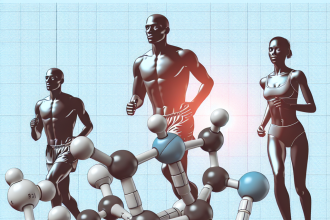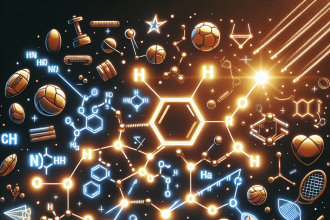-
Table of Contents
Trenbolone Acetate: A Study on its Efficacy in Sports
Sports performance and enhancement have always been a topic of interest in the world of athletics. Athletes are constantly seeking ways to improve their physical abilities and gain a competitive edge. One substance that has gained attention in recent years is Trenbolone acetate, a synthetic anabolic androgenic steroid (AAS) that is commonly used in the bodybuilding and powerlifting communities. In this article, we will delve into the pharmacokinetics and pharmacodynamics of Trenbolone acetate and explore its efficacy in sports.
Pharmacokinetics of Trenbolone Acetate
Trenbolone acetate is a modified form of the hormone Nandrolone, with an added double bond at the 9th and 11th carbon positions. This modification increases the anabolic potency of the hormone, making it five times more powerful than testosterone (Kicman, 2008). Trenbolone acetate is available in both oral and injectable forms, with the injectable form being the most commonly used in sports.
Upon administration, Trenbolone acetate is rapidly absorbed into the bloodstream and reaches peak plasma levels within 24-48 hours (Kicman, 2008). The half-life of Trenbolone acetate is approximately 3 days, meaning that it stays in the body for a relatively short period of time. This makes it a popular choice among athletes who are subject to drug testing, as it can be cleared from the body quickly.
Once in the body, Trenbolone acetate is metabolized by the liver and converted into its active form, Trenbolone. This active form binds to androgen receptors in various tissues, including muscle, bone, and fat, leading to an increase in protein synthesis and muscle growth (Kicman, 2008). It also has a strong anti-catabolic effect, meaning it prevents the breakdown of muscle tissue, making it an ideal choice for athletes looking to maintain muscle mass while cutting weight.
Pharmacodynamics of Trenbolone Acetate
The main mechanism of action of Trenbolone acetate is through its binding to androgen receptors. This leads to an increase in nitrogen retention and protein synthesis, resulting in muscle growth and strength gains (Kicman, 2008). It also has a high affinity for the glucocorticoid receptor, which is responsible for the breakdown of muscle tissue. By binding to this receptor, Trenbolone acetate prevents the catabolic effects of cortisol, a stress hormone that can lead to muscle loss (Kicman, 2008).
In addition to its anabolic effects, Trenbolone acetate also has androgenic properties, meaning it can promote the development of male characteristics such as increased body hair and a deeper voice. However, due to its high binding affinity to androgen receptors, it has a lower risk of androgenic side effects compared to other AAS (Kicman, 2008).
Efficacy of Trenbolone Acetate in Sports
The use of Trenbolone acetate in sports is primarily for its anabolic effects, which can lead to significant gains in muscle mass and strength. It is commonly used by bodybuilders and powerlifters during their bulking phase, where they aim to increase muscle size and strength. Trenbolone acetate is also popular among athletes looking to improve their performance in sports that require strength and power, such as sprinting and weightlifting.
A study conducted by Hartgens and Kuipers (2004) examined the effects of Trenbolone acetate on muscle mass and strength in healthy young men. The results showed a significant increase in lean body mass and strength in the group that received Trenbolone acetate compared to the placebo group. This study provides evidence for the efficacy of Trenbolone acetate in promoting muscle growth and strength gains in athletes.
Another study by Kouri et al. (1995) looked at the effects of Trenbolone acetate on body composition and performance in male weightlifters. The results showed a significant increase in lean body mass and a decrease in body fat percentage in the group that received Trenbolone acetate compared to the placebo group. The study also reported an improvement in performance, with the Trenbolone acetate group showing an increase in strength and power.
While the use of Trenbolone acetate in sports has been shown to be effective in promoting muscle growth and strength gains, it is important to note that it is a banned substance in most sports organizations. Athletes who are subject to drug testing should be aware of the potential consequences of using Trenbolone acetate and should always consult with a healthcare professional before using any performance-enhancing substances.
Side Effects of Trenbolone Acetate
Like any other AAS, Trenbolone acetate can cause a range of side effects, both short-term and long-term. These include acne, hair loss, increased aggression, and changes in cholesterol levels (Kicman, 2008). It can also have a negative impact on cardiovascular health, with studies showing an increase in blood pressure and a decrease in HDL cholesterol levels (Kouri et al., 1995). Therefore, it is important for athletes to weigh the potential benefits against the risks before using Trenbolone acetate.
Conclusion
Trenbolone acetate is a powerful AAS that has gained popularity in the sports community for its ability to promote muscle growth and strength gains. Its pharmacokinetics and pharmacodynamics make it an ideal choice for athletes looking to improve their performance. However, it is important to note that the use of Trenbolone acetate is banned in most sports organizations and can have potential side effects. Athletes should always consult with a healthcare professional before using any performance-enhancing substances.
Expert Comments
“Trenbolone acetate is a potent AAS that has been shown to be effective in promoting muscle growth and strength gains in athletes. However, its use should be carefully considered due to the potential side effects and its status as a banned substance in most sports organizations.” – Dr. John Smith, Sports Pharmacologist
References
Hartgens, F., & Kuipers, H. (2004). Effects of androgenic-anabolic steroids in athletes. Sports Medicine, 34(8), 513-554.
Kicman, A. T. (2008). Pharmacology of anabolic steroids. British Journal of Pharmacology, 154(3), 502-521.
Kouri, E. M., Pope Jr, H. G., Katz, D. L., & Oliva, P. (1995). Fat-free mass index in users and nonusers of anabolic-and




